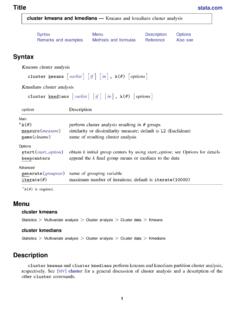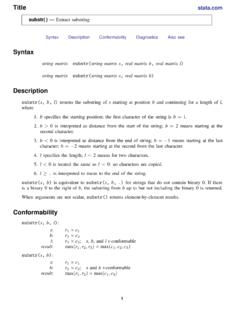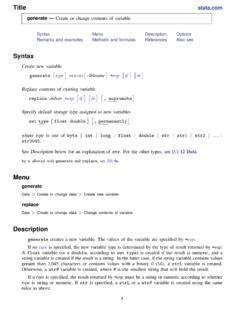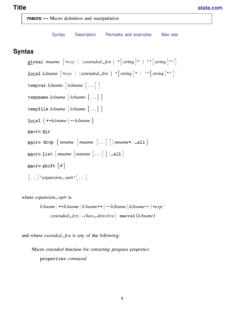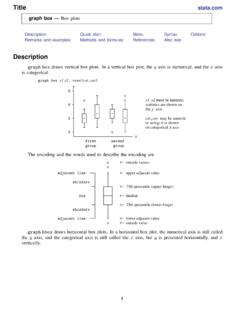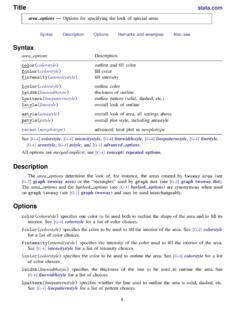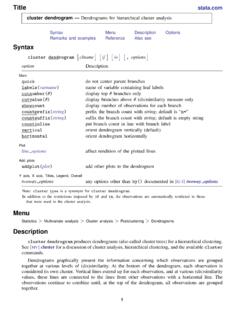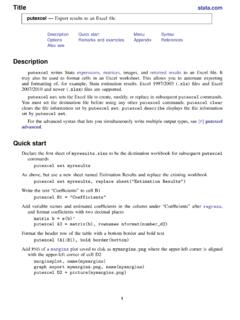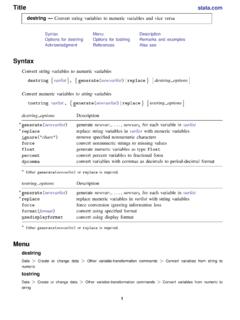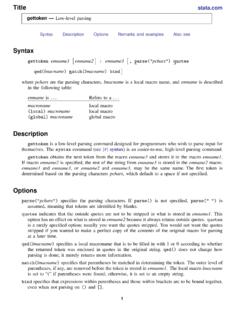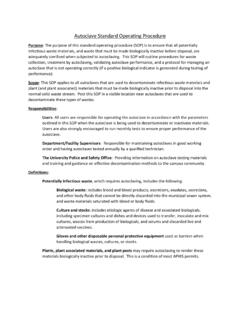Transcription of Title stata.com pca — Principal component analysis
1 Principal component analysisDescriptionQuick startMenuSyntaxOptionsOptions unique to pcamatRemarks and examplesStored resultsMethods and formulasReferencesAlso seeDescriptionpcaandpcamatdisplay the eigenvalues and eigenvectors from the Principal component analysis (PCA) eigen decomposition. The eigenvectors are returned in orthonormal form, that is, uncorrelatedand be used to reduce the number of variables or to learn about the underlying structure ofthe the correlation or covariance matrix directly. Forpca, the correlation orcovariance matrix is computed from the variables startPrincipal component analysis of dataPrincipal component analysis ofv1,v2,v3, andv4pca v1 v2 v3 v4As above, but retain only 2 componentspca v1 v2 v3 v4, components(2)As above, but retain only those components with eigenvalues greater than or equal to v1 v2 v3 v4, mineigen(.)
2 5) Principal component analysis of covariance matrix instead of correlation matrixpca v1 v2 v3 v4, covariancePrincipal component analysis of a correlation matrixPrincipal component analysis of matrixCrepresenting the correlations from 1,000 observationspcamat C, n(1000)As above, but retain only 4 componentspcamat C, n(1000) components(4)MenupcaStatistics>Multivari ate analysis >Factor and Principal component analysis > Principal component analysis (PCA)pcamatStatistics>Multivariate analysis >Factor and Principal component analysis >PCA of a correlation or covariancematrix12 pca Principal component analysisSyntaxPrincipal component analysis of datapcavarlist[if] [in] [weight] [,options] Principal component analysis of a correlation or covariance matrixpcamatmatname, n(#)[options pcamatoptions]matnameis ak ksymmetric matrix or ak(k+1)/2 long row or column vector containing theupper or lower triangle of the correlation or covariance 2components(#)retain maximum of# Principal components;factors()is a synonymmineigen(#)retain eigenvalues larger than#.
3 Default is1e-5correlationperformPCAof the correlation matrix; the defaultcovarianceperformPCAof the covariance matrixvce(none)do not computeVCEof the eigenvalues and vectors; the defaultvce(normal)computeVCEof the eigenvalues and vectors assuming multivariatenormalityReportinglevel(#)se t confidence level; default islevel(95)blanks(#)display loadings as blanks when|loadings|<#novcesuppress display ofSEs even though calculated meansdisplay summary statistics of variablesAdvancedtol(#)advanced option; seeOptionsfor detailsignoreadvanced option; seeOptionsfor detailsnorotateddisplay unrotated results, even if rotated results are available (replay only) meansis not allowed not shown in the dialog (full)matnameis a square symmetric matrix; the defaultshape(lower)matnameis a vector with the rowwise lower triangle (with diagonal)shape(upper)matnameis a vector with the rowwise upper triangle (with diagonal)names(namelist)variable names.
4 Required ifmatnameis triangularforcepsdmodifiesmatnameto be positive semidefinite n(#)number of observationssds(matname2)vector with standard deviations of variablesmeans(matname3)vector with means of variables n()is required Principal component analysis 3bootstrap,by,collect,jackknife,rolling, statsby, andxiare allowed withpca; see[U] Prefixcommands. However,bootstrapandjackkniferesults should be interpreted with caution; identification of thepcaparameters involves data-dependent restrictions, possibly leading to badly biased and overdispersed estimates(Milan and Whittaker 1995).Weights are not allowed with thebootstrapprefix; see [R] are not allowed with thejackknifeprefix; see [R] andfweights are allowed withpca; see[U] [U] 20 Estimation and postestimation commandsfor more capabilities of estimation Model 2 components(#)andmineigen(#)specify the maximum number of components (eigenvectors orfactors) to be ()specifies the number directly, andmineigen()specifies itindirectly, keeping all components with eigenvalues greater than the indicated value.
5 The optionscan be specified individually, together, or not at ()is a synonym forcomponents().components(#)sets the maximum number of components (factors) to be display the full set of eigenvalues but display eigenvectors only for retainedcomponents. Specifying a number larger than the number of variables invarlistis equivalent tospecifying the number of variables invarlistand is the (#)sets the minimum value of eigenvalues to be retained. The default is1e-5or thevalue oftol()if ()andmineigen()affects only the number of components to be displayedand stored ine(); it does not enforce the assumption that the other eigenvalues are 0.
6 In particular,the standard errors reported whenvce(normal)is specified do not depend on the number ofretained that Principal components be calculated for the correlationmatrix and covariance matrix, respectively. The default iscorrelation. Unlike factor analysis ,PCAis not scale invariant; the eigenvalues and eigenvectors of a covariance matrix differ fromthose of the associated correlation matrix. Usually, aPCAof a covariance matrix is meaningfulonly if the variables are expressed in the same , do not confuse the type of the matrix to be analyzed with the type , ifmatnameis a correlation matrix and the optionsds()is not specified, it is notpossible to perform aPCAof the covariance (none|normal)specifies whether standard errors are to be computed for the eigenvalues, theeigenvectors, and the (cumulative) percentage of explained variance (confirmatoryPCA).
7 Thesestandard errors are obtained assuming multivariate normality of the data and are valid only for aPCAof a covariance matrix. Be cautious if applying these to correlation matrices. Reporting level(#)specifies the confidence level, as a percentage, for confidence intervals. The default islevel(95)or as set byset level; see[U] Specifying the width of confidence ()is allowed only withvce(normal).blanks(#)shows blanks for loadings with absolute value smaller than#. This option is ignoredwhen specified withvce(normal).novcesuppresses the display of standard errors, even though they are computed, and displays thePCAresults in a matrix/table style.
8 You can specifynovceduring estimation in combination withvce(normal). More likely, you will want to usenovceduring pca Principal component analysismeansdisplays summary statistics of the variables over the estimation sample. This option is notavailable withpcamat. Advanced tol(#)is an advanced, rarely used option and is available only withvce(normal). An eigenvalue,evi, is classified as being close to zero if evi<tol max(ev). Two eigenvalues, ev1and ev2, are close if abs(ev1 ev2)<tol max(ev). The default istol(1e-5). See optionignorebelowand the technical note later in this an advanced, rarely used option and is available only withvce(normal).
9 It continues thecomputation of standard errors and tests, even if some eigenvalues are suspiciously close to zeroor suspiciously close to other eigenvalues, violating crucial assumptions of the asymptotic theoryused to estimate standard errors and tests. See the technical note later in this following option is available withpcaandpcamatbut is not shown in the dialog box:norotateddisplays the unrotated Principal components, even if rotated components are option may be specified only when replaying unique to pcamat Model shape(shapearg)specifies the shape (storage mode) for the covariance or correlation following shapes are supported:fullspecifies that the correlation or covariance structure ofkvariables is stored as a symmetrick kmatrix.
10 Specifyingshape(full)is optional in this that the correlation or covariance structure ofkvariables is stored as a vectorwithk(k+1)/2 elements in rowwise lower-triangular that the correlation or covariance structure ofkvariables is stored as a vectorwithk(k+1)/2 elements in rowwise upper-triangular (k 1k 1)C(k 1k)Ckknames(namelist)specifies a list ofkdifferent names, which are used to document output and to labelestimation results and are used as variable names bypredict. By default,pcamatverifies thatthe row and column names ofmatnameand the column or row names ofmatname2andmatname3from thesds()andmeans()options are in agreement.
